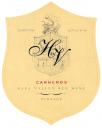 Uhhh, Scamp? You forgot the name of the wine.
Uhhh, Scamp? You forgot the name of the wine.
Actually, no. This is HdV’s meritage bottling, which they did not name until 2004. The word meritage is a cross between the words “merit” and “heritage,” and it’s the official California name for a wine that is a blend of at least two grape varietals (hard to blend just one). It rhymes with “heritage,” so please don’t go all fake French on it and say meritaaahhhhggge. Give it a good, American hard G; it’ll probably push back, as most meritage blends are Cabernet Sauvignon-based.
California winemakers started making meritage blends in honor (or imitation) of the great wines of Bordeaux, which are all blended wines. Red Bordeaux wines are blended from any or all of 5 grapes: Cabernet Sauvignon, Merlot, Cabernet Franc, Petit Verdot, and Malbec. White Bordeaux wines are blended from Sauvignon Blanc and Semillon.
In the US, we usually market a wine by its varietal, and blending makes the consumer suspicious: a “Robert Mondavi 51% Cab, 42% Merlot, 7% Cab Franc” doesn’t exactly fly off the shelves. In France, they figure all you need to know is that it’s Chateau Haut-Batailley, because the winemaker tries to make the wine taste the same from year to year, blending it differently every vintage to create the same aromas and flavors that makes that wine distinctively Chateau Haut-Batailley. This is what American winemakers are going for with their meritages: a distinctive, winery-evoking character that makes you think, “Ahhhh…. HdV.”
When enjoying this HdV premium tasting at the Lake Travis Wine Trader, I was intrigued to learn that this winery with such close ties to internationally renowned Burgundy was not making a Pinot Noir, but instead a meritage blend, a la Bordeaux.
In the glass, the wine was a rich red, not jewelled with clarity, but muscley-looking. It was quite toasty on the nose, with some green pepper aromas and a very subtle black currant scent. Overall, pretty spicy/peppery on the nose. The tannins were quite astringent on the palate, with some cranberry and maybe loganberry fruit. The finish lasted about 5 seconds. I expected it to be more fruit-driven when it warmed up a little, and it evened out a little bit, but largely stayed the same. I felt there was too much oakiness present, and the wine was not really ready to drink yet. A pretty austere red blend, for Napa Valley meritage.
To be fair, some reviewers were extremely pleased with this wine, citing rich cherry fruit from the Merlot and earthy, mushroom character, but I didn’t get any of that in my tasting. This wine is probably improved by food: a nice steak or duck dish would cast the tannins in a much more flattering light. Bottle price: $67